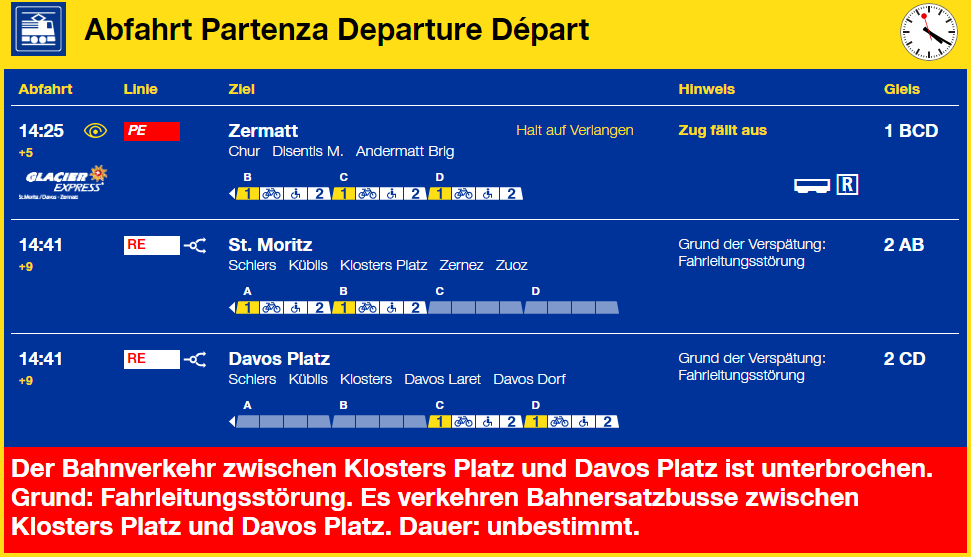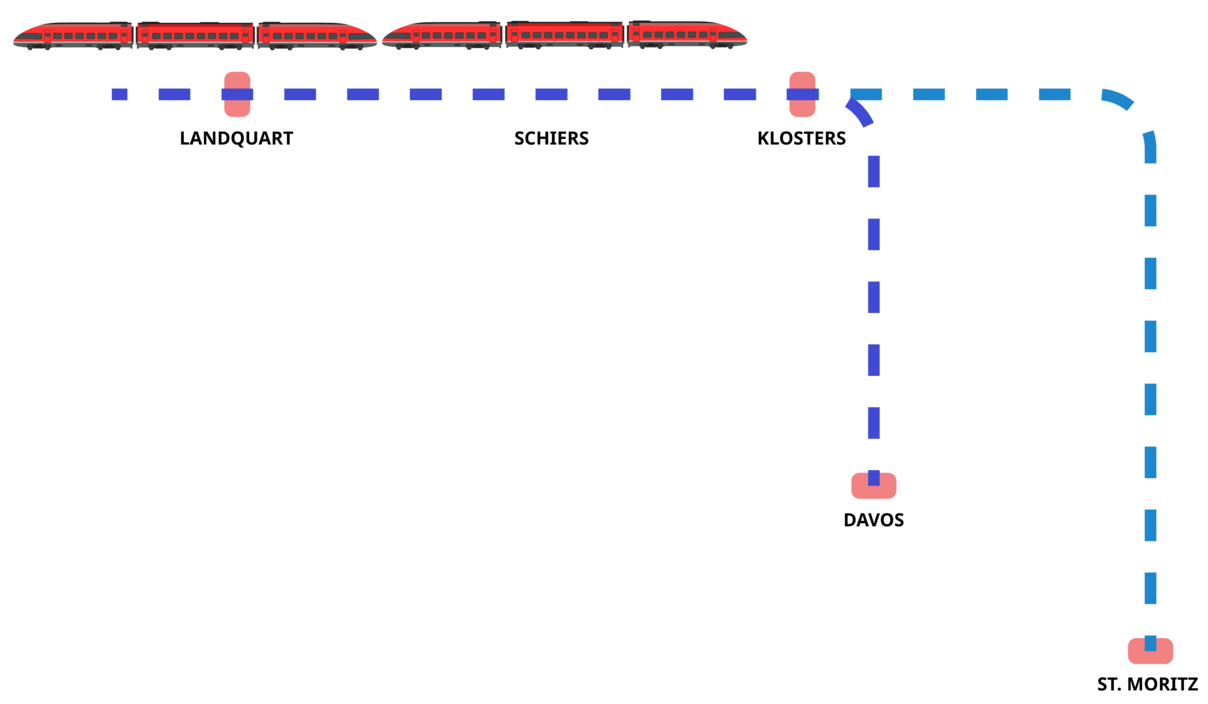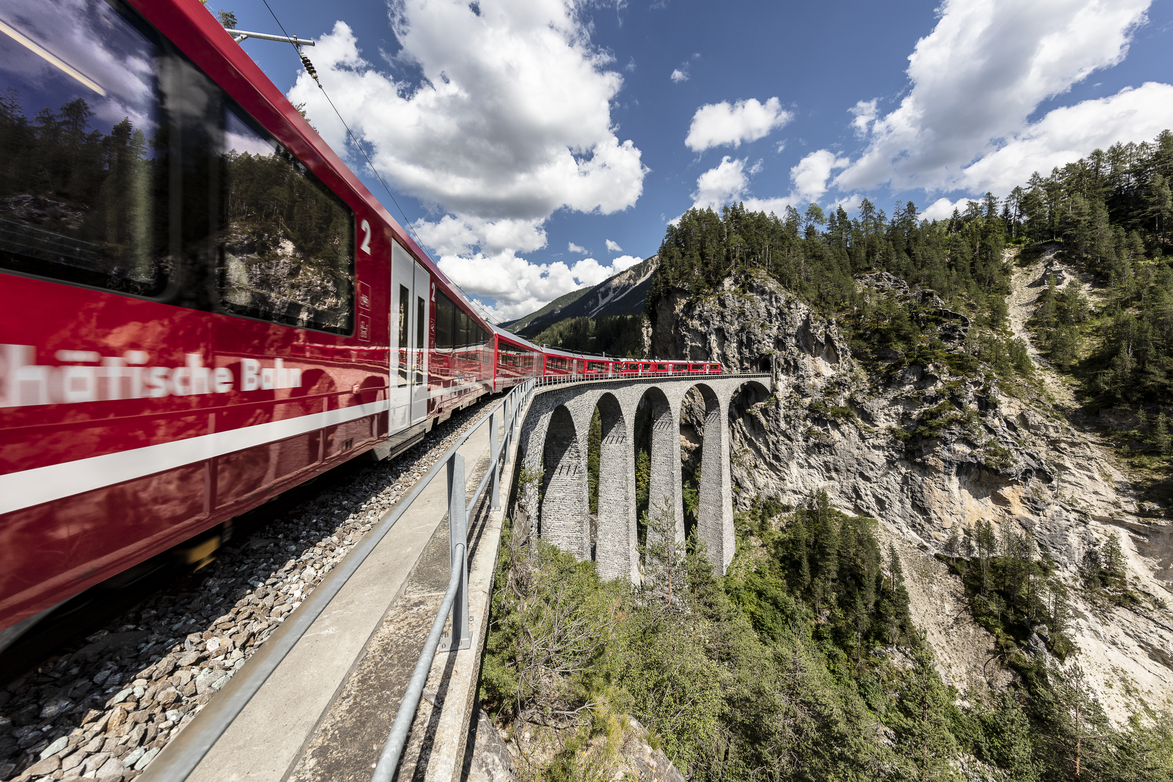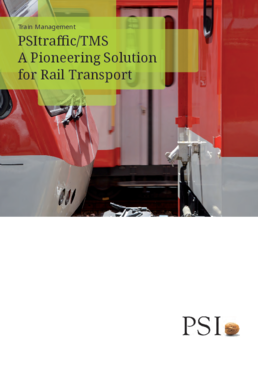One train, two destinations: Since October 2022, anyone travelling on the Rhaetian Railway may find themselves on a so-called wing train, i.e. a train that travels to different final destinations. Optimum interaction between the scheduling and passenger information systems ensures that travellers board the right part of the train and arrive at their desired destination in a relaxed manner.
Long trains - half-empty: this picture is not uncommon on less frequented routes and harbours great potential for many transport companies. This is because they only need the full train length up to a certain station. This means that the deployment of personnel, rolling stock and infrastructure is hardly economical in view of the low capacity utilisation. The famous Swiss railway company Rhaetian Railway is also familiar with this situation, for example on the routes from Landquart to Sankt Moritz and Davos. Passengers travelling to these stations often start their journey on the popular route between Landquart and Klosters, which means that capacity utilisation on this section is particularly high. In the past, the Rhaetian Railway therefore ran trains to Scuol and Davos every hour and in quick succession, which put an enormous strain on the infrastructure. Travellers to Davos also sometimes had to change trains and accept longer journey times.
In addition, our passenger numbers are growing continuously and we want to further improve our services with new connections at the hub stations. In view of these developments, we have decided to introduce and successively expand wing train operations.
While trains normally travel from one station to another, wing trains start as a composition of several multiple units. At a particular station, they then divide into two to four separate trains to ultimately travel to different terminus stations. On their return journey, the train sections are reunited into one train at the same dome station. On the Rhaetian Railway, the wing trains have been departing from Landquart as scheduled since the end of 2022 and split into train sections in Klosters in the direction of St. Moritz or Davos.
The advantages are obvious: travellers with destinations beyond Klosters no longer have to change trains. The Rhaetian Railway can also run the route to Klosters at short intervals with a full train length and thus offer more seats, while operating the sections from Klosters with shorter trains. Highly frequented routes as well as routes with fewer passengers can thus be operated more efficiently.

In the right place right from the start
As well as posing challenges for dispatching, including the exact allocation of train sections to their destination, winging places particular demands on passenger information. Passengers must be navigated to the right part of the train so that they can remain seated comfortably during their journey. Passengers must therefore be guided safely and given precise information. They must be able to see at a glance which sector their carriage is in. The Rhaetian Railway relies on its integrated PSItraffic passenger information system for this purpose. The system has been ensuring safe processes for many years, regardless of whether the train is running as a wing train, and reliably guides travellers to their desired destinations - also by using several languages.
Sector-specific information in all media
Modern displays are used for wing train operation, which are designed to process and display large amounts of information and complex operational contexts. This means that the trains are visualised with sector accuracy in all media used, including in overhead displays at stations, in the passenger app or on screens in the trains. In addition, standardised symbols are used that are easy to understand regardless of the origin, age or possible impairments of passengers. The symbol for a wing train, for example, shows a dot from which two arrows emanate.
The Head of Operational Customer Information, Tobias Perini, also emphasises the importance of displaying the sectors separately or individually for different destinations:
If the train is travelling to St. Moritz and Davos, for example, there is a separate display for both destinations and their respective routes with corresponding via stations and special information. This type of display is clear and allows all travellers to board their train with a sense of security.
In addition to the sector in which they have to stand, passengers can also see the different vehicle class(es) and features of the train composition on the station displays, e.g. where dining cars, children's or bicycle compartments are located. In the train sections themselves, you will also find displays of the respective destination everywhere, so that you can switch to the correct wing in good time during the journey if in doubt.
Fully automatic interaction
In technical terms, passenger guidance is based on seamless interaction with the control system. Via an interface to the carriage management system, this receives information on the performance characteristics as well as technical data, e.g. the length of the individual carriages. On this basis, the system calculates the stopping point at the respective platform, which in turn is the starting point for calculating and displaying the occupancy of the sectors. Wing train operation runs smoothly, not least because the visual and acoustic passenger information is adjusted fully automatically in the event of scheduling interventions, e.g. in the event of journey shortening, cancellations or failure to couple.

On the way to strategy 2030
The introduction and expansion of wing train operations as well as other operations already planned are important levers with which the Rhaetian Railway intends to achieve the goals of its "Strategy 2030". These include continuous service improvements, the development of new customer groups, further frequency increases and improved availability. Last but not least, in the long term, wing trains will above all contribute to a more efficient deployment of personnel and optimised use of the infrastructure and provide the Rhaetian Railway with valuable economic advantages.
Economical on all routes
Serving both popular and less frequented routes in an optimised manner: The Rhaetian Railway achieves this balancing act by operating wing trains. When it comes to planning and passenger information, the Swiss transport company can rely on its tried-and-tested PSItraffic scheduling and passenger information system and benefits from automated interaction as well as barrier-free communication across all media.
The Rhaetian Railway
Red trains travelling through imposing Alpine mountain landscapes, over historic viaducts and through historic tunnels:
The Rhaetian Railway (RhB) is world-famous and a third of its route is a UNESCO World Heritage Site. The fact that the RhB's railway operations run smoothly is also thanks to a complex technical system, which includes the integrated PSItraffic scheduling and passenger information system from PSI Transcom. With the introduction of wing train operations, the Swiss company has taken a further step towards optimising the deployment of staff and infrastructure while at the same time improving the service for passengers. PSItraffic also plays an important role here and helps to ensure that travellers reach their desired destination reliably and that the Rhaetian Railway uses its resources efficiently and sustainably, even on less frequented sections of the route.


